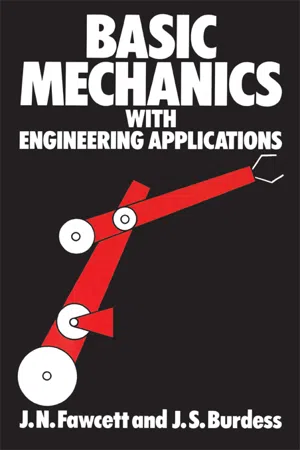Physics
Displacement
Displacement in physics refers to the overall change in position of an object, typically measured in a straight line from the starting point to the ending point. It is a vector quantity, meaning it has both magnitude and direction. Displacement can be positive, negative, or zero, depending on the direction of the movement relative to the reference point.
Written by Perlego with AI-assistance
Related key terms
Related key terms
1 of 4
Related key terms
1 of 3
6 Key excerpts on "Displacement"
- David V. Guerra(Author)
- 2023(Publication Date)
- CRC Press(Publisher)
Kinematics, first developed by Galileo, is the formal study of the motion of objects using diagrams, graphs, and equations. In the previous chapters, the analysis employed assumed the objects were either at rest or moving at a constant speed. Situations under these conditions are known as a static, because the forces are balanced. When the forces become unbalanced, accelerated motion results. In this chapter, the terminology used to describe all types of motion is formalized in preparation for subsequent chapters in which the resulting motion of unbalanced force will be studied. This chapter will start with a definition of Displacement and then explore velocity and acceleration in both graphical and analytical formats. It is important to realize that the problem-solving techniques employed in this chapter are different than those used in the previous and subsequent chapters, and this is only a brief aside to introduce the terminology and practices of kinematics.- Displacement: The Displacement (of an object is the change in position of an object relative to a fixed origin, as described in Figure 7.2 .d ⇀)FIGURE 7.2 Definition of Displacement.Displacement is a vector. Suppose that at time t0 , a particle is at position(relative to the origin of an x-y coordinate system), and at time t1 , the particle is at positionr ⇀0The Displacement that the particle undergoes from time t0 to time t1 is then given in equation (7.1) as:.r ⇀1The SI unit for the magnitude of the Displacement vector is the meter (m).(7.1)=d ⇀01−r ⇀1r ⇀0As an example of a Displacement, as depicted in Figure 7.3 , at time t0 a man is 5 m east of a lamppost and is walking directly away from the lamppost so that he is 15 m east of the lamppost at time t1 . His Displacementfrom time t0 to time t1 would be 10 m eastward.d ⇀01FIGURE 7.3 Displacement example.
- Velocity: In previous chapters, the velocity (of an object was defined as the speed of the object and the direction in which the object is moving. This definition is more precisely known of the instantaneous velocity of an object, to distinguish it from the average velocity over a known time interval. The average value-with-direction of the velocityv ⇀)v ⇀over some time interval, from time t0 to time t1 , is shown in equation (7.2) and obtained by dividing the total Displacementthat occurs during that time interval by the duration of the time interval t01 = t1 − t0 :d ⇀01The SI unit for velocity is the meter per second (m/s).(7.2)=v ⇀Avg01 s / d ⇀01t 01For example, if the man in the previous example, shown in Figure 7.3
- No longer available |Learn more
- Robert A. Pelcovits, Joshua Farkas(Authors)
- 2023(Publication Date)
- Barrons Educational Services(Publisher)
2.Earlier, we saw that Displacement is a vector (such that if an object starts and ends of the same position, positive and negative Displacements sum to zero). In contrast, total distance can never be negative and can be zero only if the object does not move at all.Definition of DisplacementTherefore, the Displacement vector points from the object’s initial position to its final position. As in one dimension, Displacement is independent of the path taken between the initial and final points (whereas total distance is path dependent). As before, Displacement ≤ total distance.3.The average velocity during a given time interval is parallel to the Displacement vector, as can be seen from the following equation (recall that multiplying a vector by a positive scalar produces a parallel vector).4.The direction, magnitude, and significance of the acceleration vector will be discussed later in this chapter.Problem Solving: Two Dimensions
Because two-dimensional vector equations reduce to independent one-dimensional equations, the different components of motion are entirely independent of each other (other than being time synchronized). Therefore, kinematics problems in two dimensions can be solved by applying one-dimensional kinematics equations to each particular dimension and coordinating the motion by using a single time parameter.TIP Two-dimensional kinematics problems are solved by treating each dimension using the one dimensional methods shown earlier.Sally is chasing Calvin. Calvin is moving along a path defined by the position vector Sally is moving along the path (a)Will Sally catch Calvin? (b)If so, what will the angle between their two velocities be at the time of impact?Example 2.8 A Two-dimensional Collision ProblemSolution(a)For two point objects to collide, they must have equal x- and y-components at a particular instant of time. Mathematically speaking, we write down the simultaneous equations x(t)Calvin = x(t)Sally and y(t)Calvin = y(t)Sally and see if there are any solutions to these two equations with a common value of t - eBook - ePub
- Hiqmet Kamberaj(Author)
- 2021(Publication Date)
- De Gruyter(Publisher)
4 Two- and three-dimensional motionIn this chapter, we will discuss the kinematics of a particle moving in two and three dimensions. Utilizing two- and three-dimensional motion, we will be able to examine a variety of movements, starting with the motion of satellites in orbit to the flow of electrons in a uniform electric field. We will begin studying in more detail the vector nature of Displacement, velocity, and acceleration. Similar to one-dimensional motion, we will also derive the kinematic equations for three-dimensional motion from these three quantities’ fundamental definitions. Then the projectile motion and uniform circular motion will be described in detail as particular cases of the movements in two dimensions.4.1 The Displacement, velocity, and acceleration vectors
When we discussed the one-dimensional motion (see Chapter 3 ), we mentioned that the movement of an object along a straight line is thoroughly described in terms of its position as a function of time,x ( t ). For the two-dimensional motion, we will extend this idea to the movement in thex yplane.As a start, we describe a particle’s position by the position vector r pointing from the origin of some coordinate system to the particle located in thex yplane, as shown in Fig. 4.1 . At timet ithe particle is at point P, and at some later timet fit is at the position Q. The path from P to Q generally is not a straight line. As the particle moves from P to Q in the time intervalΔ t =, its position vector changes fromt f−t ir itor f.Definition 4.1 (Displacement vector).
The Displacement is a vector, and the Displacement of the particle is the difference between its final position and its initial position. We now formally define the Displacement vector for the particle as the difference between its final position vector and its initial position vector:(4.1)Δ r =r f−r i.The direction ofΔ ris indicated in Fig. 4.1 from P to Q. Note that the magnitude ofΔ r - Richard Leach(Author)
- 2014(Publication Date)
- William Andrew(Publisher)
Section 2.3 ).2. Distance – It is a quantitative measure of how far two objects are apart. In mathematics, a distance is called a metric. Distance is also measured in metres and is a scalar quantity.3. Displacement – It is the distance between an initial position and a subsequent position of a moving object, measured in metres. In mathematics, Displacement is defined as the shortest path between the final point and the initial point of a body and is a vector quantity.4. Position – It is the spatial location of an object, quantified as a spatial coordinate and is a vector quantity. Position is always relative to the origin of a one-dimensional coordinate system; a line, such as an axis of a two-dimensional coordinate system; or a plane, such as the reference surface in a three-dimensional coordinate system. In physics, position is the location in space of a physical body. In the rigid-body approximation, where the configuration of that body is fully specified by six generalised coordinates (three linear and three rotational) corresponding to its six degrees of freedom, position is given by the three linear coordinates.There is also a large range of terms and definitions that are relevant to Displacement sensors. The following list is not exhaustive but presents just some of the characteristics that need to be determined when considering a Displacement sensor (see Ref. [4] for a thorough review of all these terms):• response curve – offset, sensitivity and non-linearity; • drift and stability; • bandwidth; • noise; and • resolution.5.3 Displacement interferometry
5.3.1 Basics of Displacement interferometry
Displacement interferometry is usually based on the Michelson configuration or some variant of that basic design. In Chapter 4 , we introduced the Michelson and Twyman–Green interferometers for the measurement of static length, and most of the practicalities in using such interferometers apply to Displacement measurement. Displacement measurement, being simply a change in length, is usually carried out by counting the number of fringes as the object being measured (or reference surface) is displaced. Just as with gauge block interferometry, the Displacement is measured as an integer number of whole fringes and a fringe fraction. Displacement interferometers are typically categorised as either homodyne systems (single frequency) or heterodyne systems (two frequencies). Homodyne Displacement interferometers require at least two fringe patterns that are 90° out of phase (referred to as phase quadrature) to allow bidirectional fringe counting and to simplify the fringe analysis. Heterodyne Displacement interferometers use a frequency modulation method where the two optical frequencies produce a nominal heterodyne frequency, typically in the megahertz regime. The phase of the measurement signal is then tracked relative to an optical reference that is detected at the heterodyne frequency. Photodetectors and digital electronics are used to count the fringes, and the fraction is determined by electronically sub-dividing the fringe [7] . With this method, fringe subdivisions of λ /1000 are common, giving sub-nanometre resolutions for both heterodyne and homodyne systems. There are many homodyne and heterodyne interferometers commercially available, and the realisation of sub-nanometre accuracies in a practical setup is an active area of research [8 ,9] . Many of the modern advances in high-accuracy interferometry come from the community searching for the effects of gravitational waves [10]- eBook - ePub
Introductory Physics
Summaries, Examples, and Practice Problems
- Michael Antosh(Author)
- 2023(Publication Date)
- CRC Press(Publisher)
Time. When we describe something moving, we’ll be looking at the motion between two time points: an initial time point and a final time point. The initial time point is where we start watching the motion, and the final time point is when we stop watching the motion. The amount of time between the initial and final time points is called the time. In this textbook we’ll use the symbol Δt. In SI units, time is given in seconds, abbreviated s. Time only has a magnitude.2.3 Displacement, Position, and Coordinate Systems
Displacement is one of the most important quantities in physics. It’s a change in position, with position being the location of an object. Displacement can be defined as:Δ x =x f−xi(2.3.1) In this equation, Δx is Displacement. Δ is the Greek letter delta, and it goes in front of any physics quantity that is a change in some amount. Here, it is the change in position. xf and xi are the positions at the final (f) and initial (i) time points of a problem.Position is always measured on what is called a coordinate system. For objects moving in a straight line (the topic of this chapter), the coordinate system has two things:- An origin, which is the center of your coordinate system.
- A positive direction.
A straight-line coordinate system is shown in Figure 2.1 , with “to the right” being the positive direction.FIGURE 2.1An example of a straight line coordinate system, with three example positions.When solving a problem, you get to choose the coordinate system, meaning that you get to choose the origin and the positive direction. If you only need the Displacement, and not the position, you will only need to choose a positive direction. Almost all (or maybe all) of the problems in this textbook will only need Displacement, not position, and the Displacement will often be obvious in the problem – something like “calculate the velocity of a bus that moved 25.0 m”. The 25.0 m is the Displacement.Side note: in this chapter, the Displacement will have two parts to it:- An amount: the distance moved (in units of meters). This is sometimes called the magnitude
- eBook - ePub
- J Jones, J Burdess, J Fawcett(Authors)
- 2012(Publication Date)
- Routledge(Publisher)
OY axis is superfluous.Position and DisplacementThe position of a point at P may be described by its distance x along the line OX, as shown in Fig. 1.7 . In this case the position vector of the point is r = x. If the point now moves to P' such that its new position vector is x + δx, the change in position δx is called the Displacement of the point.FIG . 1.7The number of degrees of freedom of a point is always equal to the number of independent co-ordinates needed to specify its Displacement. In this case the Displacement can be expressed in terms of a change in the single coordinate x, so that a point moving on a straight line has one degree of freedom. Since the direction of the Displacement vector is specified by the straight line, all vectors must lie along OX. Hence when adding these vectors, the vector triangle of Fig. 1.3 will reduce to a straight line. This is equivalent to simple scalar addition, taking account of sign.The recommended SI units for position and Displacement are metres, m, or millimetres, mm.VelocityConsider the point P with position x at time t. Let the point be moving such that a small time δt later it has moved to a new position x + δx. The Displacement δx is the change in position, and is assumed to be positive in the same sense as x, i.e. along OX. The velocity ν of the point is defined as its rate of change of position and is given byThis limit defines the velocity of the point at position x. The derivative dx/dt is often written as , where the dot denotes differentiation with respect to time.Velocity, like position, is a vector quantity and in the case of straight line motion its direction is defined by its sign, which is the same as that of the incremental Displacement δx. The recommended SI unit of time is the second, s, so that the SI unit of velocity will be m s−1
Index pages curate the most relevant extracts from our library of academic textbooks. They’ve been created using an in-house natural language model (NLM), each adding context and meaning to key research topics.
Explore more topic indexes
Explore more topic indexes
1 of 6
Explore more topic indexes
1 of 4





